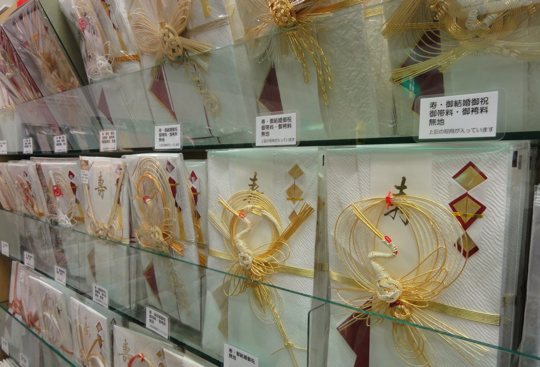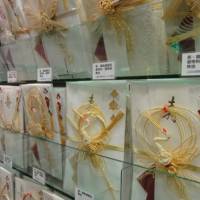Dear Alice,
I am fascinated by the elaborately decorated envelopes offered for sale in Japan. I know they are used for giving money, because the first time I came to Japan to study martial arts a friend taught me to put my lesson fees into an envelope, rather than just hand bills to my teacher. I'd like to use fancy envelopes on my next visit but I've heard some are only for weddings or funerals and I'm afraid I'll make a mistake. Can you explain the differences? Actually, can you explain why the heck money has to go into envelopes in the first place?
Daniel A., Lisbon, Portugal
Dear Daniel,
The general term for what you've described is "kinpū," and you're absolutely correct that there are different types. The ones for auspicious occasions, such as a wedding or birth, are generally called shūgibukuro, while those for funerals are fushūgibukuro or kōdenbukuro. Within those broad categories, there are different types for different uses, including those for celebrating a new home (shinchiku iwai) or a new baby (shussan iwai).
Now that I think of it, it's probably a bit misleading to use the word "envelope" for these, as they're nothing like the run-of-the-mill envelopes that arrive in your mailbox. A proper kinpū is hand folded, never glued, and is closed with a stiff handmade decorative tie called a mizuhiki. Think origami with an over-the-top bow.
If you're buying something in a store or restaurant, it is fine to present your bills mukidashinomama, or naked as the day they were printed. But in just about every other situation, including paying for a lesson or offering an honorarium, you need to keep that cash covered. I knew this, but I had no idea why. To find out, I took your question to Kiyotada Ogasawara, the 31st patriarch of the Ogasawara School of Etiquette and author of multiple books on traditional warrior-class manners.
The important thing to understand, Ogasawara told me, is that money isn't wrapped because it's money; it's wrapped because it's a gift. "Paper was once a rare and costly material. We know from old documents, including an 11th-century text called the 'Oshugosannenki,' that gifts of money were once made by stacking gold coins on a decorative tray and laying a sheet of paper over it," he explained. Later, as production expanded and paper became more affordable, a custom gradually developed of actually enclosing gifts in paper.
"The primary reason to wrap money is to add beauty, but the outer wrapping serves two other important purposes," Ogasawara said. "The custom is that the person making the gift writes his or her name on the outside, as well as an indication of how much is inside. This provides the recipient with a record of the gift, which is particularly helpful when receiving many gifts at once, and at events like weddings and funerals where the custom is to return a portion of the gift at a later date."
The final reason for enclosing the cash is to spare the recipient from having to handle the bills. "Money passes through many people's hands, and can carry germs and filth," Ogasawara observed. "In Japan, we are taught to wash our hands after handling money, but it's not always convenient to do so. Offering money wrapped in paper shows consideration for the recipient, because they can receive it without having to touch it directly."
The proper thing is to make your own kinpū, according to Ogasawara, who nevertheless acknowledges that only a tiny percentage of Japanese do this, or know enough to do it right.
"There are conventions about how to fold the paper, depending on whether it's a happy or unhappy occasion, as well as which colors and designs can be used," he said. "These are beautiful and refined customs that ought to be practiced and passed on, but nowadays people are always looking for the easy way out."
There's certainly no shortage of short cuts available. You can buy ready-made kinpū in department stores, Japanese-paper shops and even on Amazon Japan. Many of these are hand-crafted and could conceivably be passed off as your own work. It's also possible to buy inexpensive envelopes that bear a printed approximation of the mizuhiki, and there are now even downloadable templates you can use to print one from your home computer.
Sticklers for tradition write their name with brush and ink, rubbing fresh ink in an ink stone, but most people now use felt-tip pens marketed expressly for this purpose. Pentel, for example, makes a double-tipped pen called the Keicho Sign Pen. ("Keichō" means "congratulations and condolences.") One end is marked "kuro" ("black") and is for auspicious occasions. The other end is marked "usuguro" (literally "thin black") and is used only for funerals. A sales rep gave me a demonstration, writing a few characters that came out in a washed-out, barely-there gray. He explained that when writing a funeral envelope you're supposed to use a lighter shade of ink to suggest that your tears fell into the ink stone and thinned the ink.
While there is plenty of information available in Japanese on how to give money, I didn't find much in English that I would deem reliable. My advice would be to visit a specialty shop that sells both ready-made kinpū and the supplies to make your own. Staff at such stores are usually very knowledgeable and can help you make an appropriate selection.
Give them as much information as possible, including the occasion for your gift, your relation to the recipient and about how much you intend to give. If you're going to a funeral, try to find out in advance whether it's a Buddhist or Christian funeral because the conventions for money envelopes differ.
Good stores for this purpose include Ito-ya, which has branches all around greater Tokyo, and Kyukyodo, a Kyoto-based Japanese-paper shop with a branch in Tokyo's Ginza district. Haibara in Tokyo's Nihonbashi district is another excellent choice.


















With your current subscription plan you can comment on stories. However, before writing your first comment, please create a display name in the Profile section of your subscriber account page.